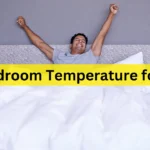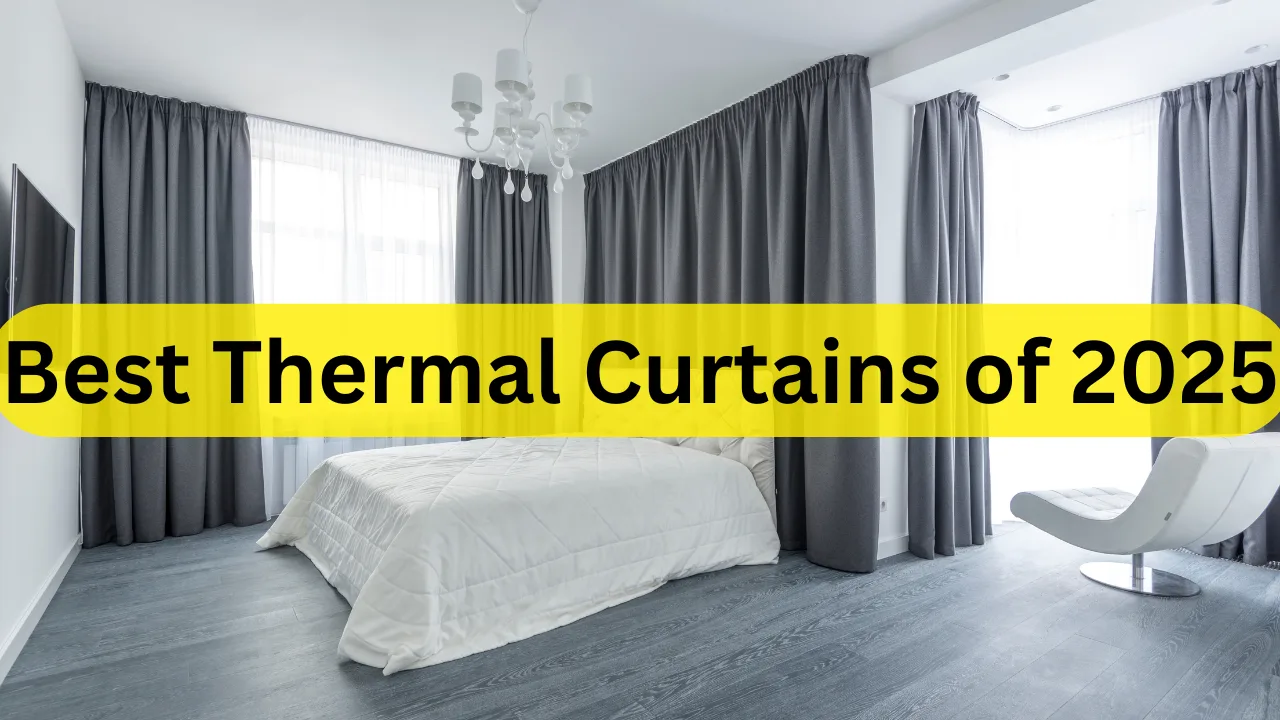Looking for a budget-friendly way to keep your bedroom warm and block out unwanted light? Thermal curtains are an effective solution. Not only do they help reduce energy bills by insulating your windows, but they also offer sound reduction and complete darkness—ideal for light-sensitive sleepers and anyone looking to improve sleep quality year-round.
Thermal curtains use multiple fabric layers, often with a foam backing or triple weave design. These materials trap heat during winter, block solar heat during summer, and create a quieter, cozier space for rest.
Top 5 Best Thermal Curtains for Winter
Here are the top 5 thermal curtains to consider in 2025:

1. HPD Thermal Room Darkening Curtain
Best for Budget & Performance
- 100% polyester with weighted hem
- 3″ curtain rod pocket with back tabs and hook belt
- Available in 5 color options
- Offers two header styles: rod pocket or grommet
- Four sizes to fit most windows
- Great for single-pane windows or drafty rooms
2025 Price: Start from $79 per panel
2. BHF Linen Total Thermal Curtains
Best Linen Look with Full Blackout
- 100% polyester with full blackout coating
- Comes in sets of 2 panels
- Each panel has 8 silver grommets (1.6″ diameter)
- Machine-washable and energy efficient
- Available in multiple colors and sizes (63″ to 108″)
- Ideal for privacy and insulation
2025 Price: Start from $89 per set

3. Nicetown 4 Layer Thermal Curtains
Best Customizable and Noise-Reducing Option
- Triple weave blackout fabric + melt-blown cloth for filtration
- Reduces PM2.5 particles and outside noise
- 100% blackout with soundproofing
- Available in 23 colors and 7 header styles
- Wide range of sizes
- Machine-washable (remove felt liner before washing)
2025 Price: Start from $49 per panel
4. Nicetown 4 Layer Thermal Blackout Curtains
Best for Total Light Blocking and All-Season Insulation
- Multi-layer design with melt-blown fabric for added thermal control
- Helps block dust and particles (PM2.5)
- 100% blackout with effective sound insulation
- Comes in a wide range of colors and sizes
- Choose from multiple header styles (grommet, rod pocket, pleated)
2025 Price: Start from $49 per panel

5. Deconovo Thermal Insulated Blackout Curtains
Best for Modern Style and Energy Savings
- 100% polyester with smooth finish and triple weave design
- Blocks sunlight and UV rays effectively
- Reduces outside noise and improves sleep environment
- Machine washable and wrinkle-resistant
- Comes in dozens of modern shades and patterns
2025 Price: Start from $39 per panel
What You Need to Know About Thermal Curtain
Whether you’re buying your first pair or upgrading to a more efficient option, understanding how thermal curtains work helps you make the most of your investment.
What is a Thermal Curtain?
A thermal curtain is a specially designed window treatment that helps insulate a room by reducing heat transfer through windows. These curtains keep warm air in during the winter and block heat from entering in the summer. They’re ideal for bedrooms, nurseries, home offices, or any drafty room that needs temperature control.
What Are Thermal Curtains Made Of?
Thermal curtains are usually made with three or more fabric layers. The outer layers are decorative polyester or cotton, while the middle layer is an insulating foam, felt, or blackout liner. Some advanced options include melt-blown fabric or PVC backing for dust blocking and filtration.
Can Thermal Curtains Be Washed?
Most thermal curtains are machine washable, but always check the manufacturer’s care label. Typically, you’ll want to:
- Remove any felt liners or removable insulation
- Wash on a gentle cycle with cold water
- Avoid bleach or fabric softeners
- Air dry or tumble dry on low
Do Blackout Curtains Insulate Like Thermal Curtains?
Not always. While blackout curtains block light effectively, only some are also thermal. True thermal curtains include specific insulating layers that reduce heat transfer. However, some blackout curtains (especially triple weave models) do offer light insulation benefits—just not as much as dedicated thermal curtains.
Thermal vs. Blackout Curtains: What’s the Difference and What to Look For
While thermal and blackout curtains are often grouped together, they serve different primary purposes. Understanding the difference can help you choose the right window covering for comfort, energy savings, or total darkness.
What is the Difference Between Thermal and Blackout Curtains?
- Blackout Curtains: These are made to block out all incoming light. They’re perfect for bedrooms, nurseries, and media rooms where light control is essential. While some offer insulation, their main purpose is darkness.
- Thermal Curtains: These are designed for insulation and energy efficiency. They help regulate room temperature by reducing heat loss in winter and heat gain in summer. Some thermal curtains also include blackout features, but not all do.
If you need both darkness and insulation, look for curtains labeled as thermal blackout for dual benefits.
Things To Look For in Thermal Curtains
Whether you’re shopping for warmth or noise control, keep these core features in mind:
The Amount of Layers
- 2 Layers: Basic protection, often just blackout with light insulation
- 3 Layers: Includes a thermal lining or foam core for energy efficiency
- 4+ Layers: Often include melt-blown fabric or noise-reducing inserts for advanced insulation and soundproofing
The Type of Material
- Polyester: Most common, durable, and easy to maintain
- Cotton Blends: Softer appearance, but usually needs extra lining to insulate
- Triple Weave Fabric: Offers blackout and moderate insulation
- Foam Backing or Felt Liners: Excellent for drafty rooms and colder climates
Choosing the right number of layers and materials ensures your curtains match your insulation and light-blocking needs year-round.
Curtain Header Styles: Which One Works Best for Thermal Curtains?
Choosing the right header style is more than just an aesthetic decision—it also affects how your thermal curtains hang, insulate, and operate. Here’s a quick breakdown of the most common header types.
Rod Pocket
- Look: Traditional and gathered
- Function: The curtain rod slips through a sewn-in pocket at the top
- Pros: Clean, classic appearance
- Best for: Stationary curtains that stay closed most of the time
Grommet
- Look: Modern and structured
- Function: Large metal rings line the top for easy sliding on the rod
- Pros: Easy to open and close; works well with heavy fabrics
- Best for: High-traffic windows or daily use
Tab Top
- Look: Casual and airy
- Function: Fabric loops are sewn along the top edge
- Pros: Decorative and easy to hang
- Best for: Lightweight thermal curtains in informal spaces
Pinch Pleat
- Look: Formal and tailored
- Function: Pleats are sewn in and gathered, usually hung on hooks
- Pros: Creates a structured, luxurious drape
- Best for: Formal rooms or layering behind sheers
Conclusion
Thermal curtains can transform your bedroom into a quieter, darker, and more temperature-controlled retreat. Whether you’re trying to insulate against winter drafts or block out summer heat, pairing the right fabric with the right curtain style makes all the difference.
From triple-weave polyester to foam-backed blackout panels, you’ll find plenty of energy-efficient options in 2025. Choose based on your needs—whether that’s better sleep, energy savings, or simply a cozier atmosphere.
FAQ: Thermal Curtains
Have questions about how thermal curtains actually work or whether they’re worth the investment? Here are clear answers to the most common ones.
Yes, thermal curtains are effective at reducing heat transfer through windows. They create an insulating barrier that helps keep indoor temperatures stable—blocking heat during summer and retaining warmth in winter. They also reduce outside noise and block light in many models.
Absolutely. If you want to save on energy costs, improve sleep quality, or block outside noise, thermal curtains are a cost-effective solution. They are especially valuable in bedrooms, nurseries, and drafty areas.
Yes. Thermal curtains help keep cold air from seeping into your room through windows by acting as a thick, layered barrier. In colder climates, they’re particularly useful for maintaining warmth and reducing your heating bill.



